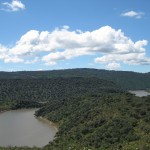The Tajo River is the common element of this space and it is the natural border between Spain and Portugal. The natural characteristics are identical on both sides of the border. The conservation of riparian forests with river canyons that prevent its use for agriculture and the existence of numerous species of flora and fauna including in the Birds Directive and Habitat as well as habitats of Community interest are included as National Park in 2000. About 80% covers Special Protection Area (SPA).
Particularly, the protected area corresponds to the valleys of the Tajo, Ponsul, Aravil and Erges. It is characterized by very pronounced slopes, covered of dense Mediterranean vegetation, with frequent rocky outcrops, which dominates the shale dotted with granite. Adjacent areas are more flattened and covered with oaks, eucalyptus cultivation areas (rainfed cereals and olive trees), grasses and sclerophyllous forests. The features are similar to those of the International Douro Arribes but here are much smaller, with a greater width of the river.
This mosaic of semi-natural habitats with little human intervention is mixed from pastures, areas of agricultural and livestock that along with management of increasingly organized hunting, it allows the existence of important bird populations that live among the rocks, especially those of Mediterranean forests. These last are in the most endangered in Europe. For instance, we might mention the Iberian imperial eagle and the black vulture. In the steep slopes of the valley of the Tagus River and its tributaries, the black stork, eagle owl, Egyptian vulture, griffon vulture, Bonelli’s eagle, golden eagle and black wheatear nest there.
On the Portuguese side, you can still find the sandgrouse, a species thought to be extinct in Portugal.



